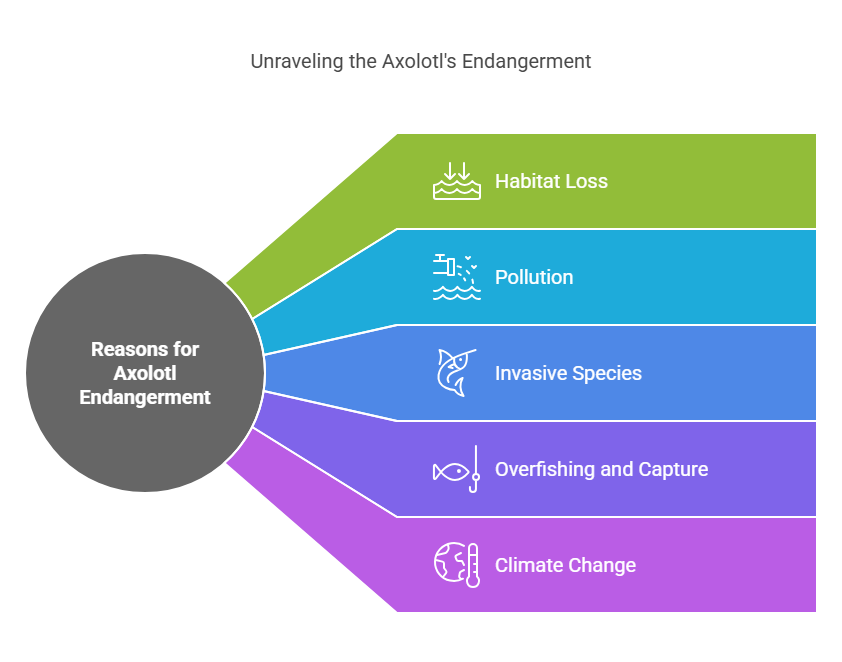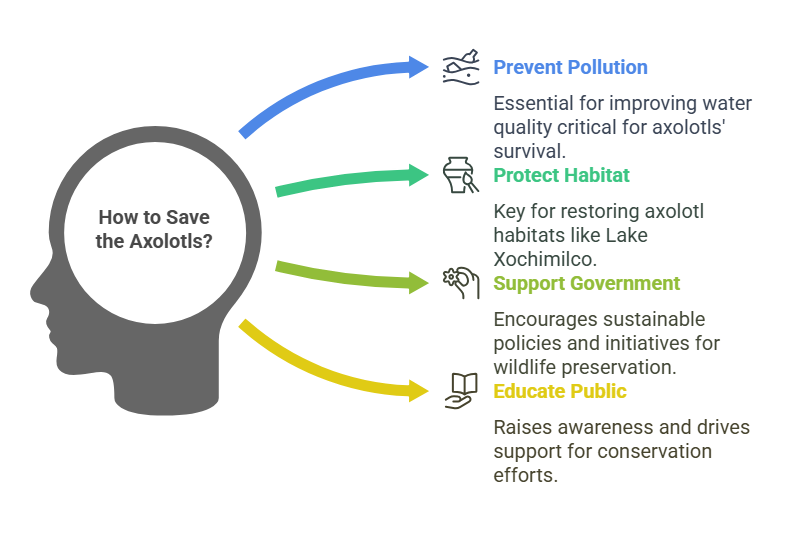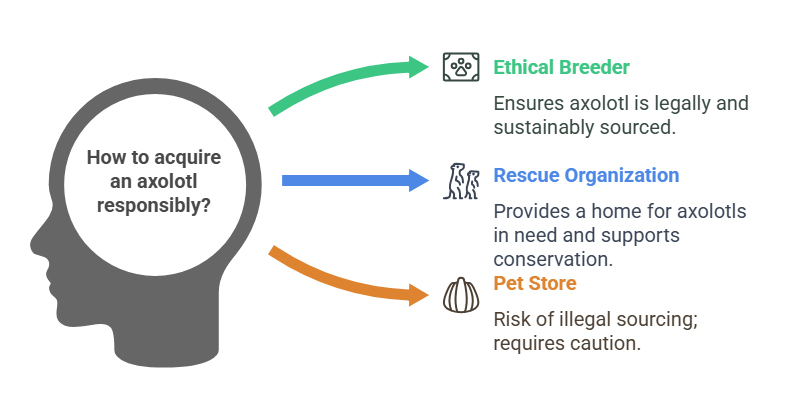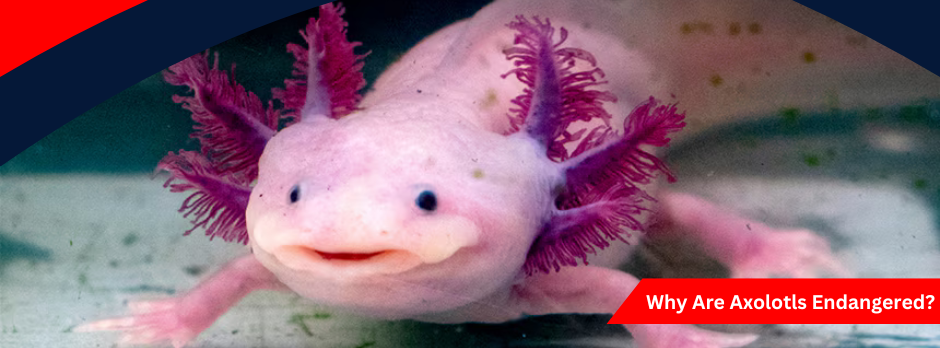Axolotls, also known as Mexican walking fish, have fascinated scientists and pet lovers alike. But their survival is under threat. Understanding why axolotls are endangered and what can be done to help them is crucial for ensuring their future.
What Is an Endangered Species?
An endangered species is a plant or animal at risk of extinction. This means their population numbers have dropped dangerously low. The International Union for Conservation of Nature (IUCN) monitors and classifies these species. Axolotls are listed as critically endangered. This classification means they face a very high risk of disappearing from the wild forever.
Endangered species often lose their habitats due to human activities. Pollution, overfishing, and climate change also contribute. Axolotls’ story is a prime example of these threats.
Reasons Axolotls Are Endangered
Here we will discuss the most popular reasons axolotls are endangered species today
Habitat Loss
Axolotls are native to lakes and canals in Mexico. Specifically, they inhabit Lake Xochimilco and Lake Chalco. Urban development has drastically reduced these habitats. Lake Chalco no longer exists as a natural body of water. Meanwhile, Lake Xochimilco has shrunk to a network of canals.
Pollution
Industrial waste and agricultural runoff pollute the remaining waterways. Chemicals and garbage harm the water quality. Axolotls rely on clean water to thrive. Pollution introduces toxins that weaken their immune systems, making them prone to disease.
Invasive Species
Non-native fish such as tilapia and carp now populate the axolotls’ habitat. These fish compete for food and prey on axolotl eggs. This added competition puts further strain on their already fragile population.
Overfishing and Capture
Axolotls are also captured for research, medicine, and the pet trade. While regulated in many places, illegal capture continues. This directly reduces their wild numbers.
Climate Change
Changing temperatures impact the delicate ecosystem of their habitats. Warmer water can reduce oxygen levels, making it harder for axolotls to survive.

How Many Axolotls Are Left in the World in 2025?
As of 2025, there are fewer than 1,000 axolotls left in the wild. Some estimates suggest the number could be as low as 50 in their natural habitats. Captive populations are much higher, with thousands raised for pets, research, and conservation.
The wild population continues to decline despite conservation efforts. A study by the Universidad Nacional Autónoma de México highlighted this alarming trend Without intervention, axolotls could vanish from their natural environment.
How to Save the Axolotls
The axolotl, also known as the Mexican walking fish, is a critically endangered amphibian that inhabits only a few waterways in Mexico. Once common throughout Mexico, the axolotl has been decimated by pollution and habitat loss. In recent years, conservation efforts step up to save this unique creature, and there are efforts underway to breed them in captivity.

Here are the top 5 things we can do to save the axolotl:
Prevent Pollution
Reducing water pollution is essential. Limiting industrial and agricultural waste that enters lakes and canals can improve water quality. Clean water is critical for axolotls’ survival.
Protect Their Habitat
Protecting and restoring axolotl habitats like Lake Xochimilco is a key step. Local governments and environmental groups are already working to clean these areas and reintroduce native plants.
Support the Mexican Government
The Mexican government plays a major role in conservation. Supporting policies and initiatives aimed at preserving wildlife can make a significant impact. Encouraging sustainable tourism also helps fund conservation.
Educate the Public
Spreading awareness about axolotls and their endangered status can drive more support. Schools, campaigns, and documentaries can highlight their plight and encourage conservation actions.
Raise Awareness
Engaging with social media, organizing events, and supporting conservation days can amplify the message. Raising awareness about axolotls’ struggles can inspire global action to save them.
If Axolotl Is Endangered, How Can You Get One as a Pet?
Axolotls are listed as critically endangered, yet owning one as a pet is still possible in many places, thanks to the widespread availability of captive-bred specimens. It’s essential to buy from ethical breeders to ensure your axolotl is legally and sustainably sourced. Many licensed breeders sell them online, often offering a variety of colors and sizes. However, it’s equally important to verify the seller’s credentials and adhere to local laws, as regulations vary by state. Some regions prohibit owning axolotls altogether, while others allow them under specific conditions.
Pet stores may occasionally stock axolotls, but caution is advised as some may source their animals illegally. Always ask where the axolotls come from before purchasing. Adopting an axolotl from a rescue organization is another responsible option. Many axolotls end up in shelters when owners are unprepared for their care requirements. These amphibians need cool, clean water, ample tank space, and a specific diet of live or frozen foods like worms and brine shrimp.
Axolotls are not low-maintenance pets and require significant commitment. They can be messy and unsuitable for small children. Before deciding to bring one home, thoroughly research their care needs and prepare the proper environment. By adopting or purchasing from ethical sources, you not only gain a unique pet but also contribute to reducing pressure on wild populations. Responsible ownership can raise awareness and support conservation efforts for this remarkable species.
Despite their endangered status in the wild, axolotls are popular pets. Captive-bred axolotls are legal to own in many places. Here’s how to get one responsibly:
- Choose a Licensed Breeder Only buy from reputable breeders who follow ethical practices. Avoid taking axolotls from the wild.
- Understand Their Needs Axolotls require specific tank conditions. These include cool water, plenty of space, and a proper diet. Educate yourself thoroughly before bringing one home.
- Check Local Laws Some states and countries regulate or ban axolotl ownership. Ensure it’s legal in your area.
Owning an axolotl is a big responsibility. Proper care can ensure they thrive in captivity.

Final Thoughts
Axolotls are unique creatures with remarkable regenerative abilities. Yet, their survival depends on collective action. Restoring habitats, supporting conservation, and spreading awareness are essential.
Even as pets, axolotls remind us of the importance of preserving biodiversity. By making informed choices, we can help save them from extinction.
FAQs
1. Are axolotls only found in Mexico?
Yes, wild axolotls are native to Mexico, specifically Lake Xochimilco.
2. Why are axolotls called “walking fish”?
Though they live underwater, their limbs allow them to walk along the lakebed.
3. How long do axolotls live?
In captivity, axolotls can live up to 15 years with proper care.
4. Can axolotls regenerate any body part?
They can regenerate limbs, spinal cord parts, and even portions of their heart and brain.
5. What is the best way to support axolotl conservation?
Donating to organizations and supporting habitat restoration projects are great ways to help.

